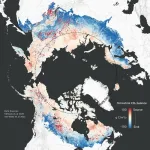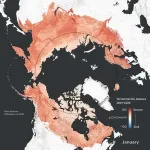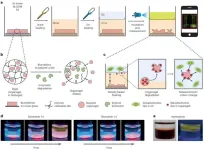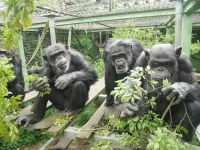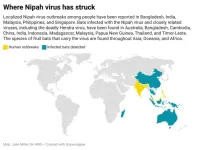(Press-News.org) After millennia as a carbon deep-freezer for the planet, regional hotspots and increasingly frequent wildfires in the northern latitudes have nearly canceled out that critical storage capacity in the permafrost region, according to a new study published in Nature Climate Change.
An international team led by Woodwell Climate Research Center found that a third (34 percent) of the Arctic-boreal zone (ABZ)—the treeless tundra, boreal forests, and wetlands that make up Earth’s northern latitudes—is now a source of carbon to the atmosphere. That balance sheet is made up of carbon dioxide (CO₂) uptake from plant photosynthesis and CO₂ released to the atmosphere through microbial and plant respiration.
When emissions from fire were added, the percentage grew to 40 percent.
The findings represent the most current and comprehensive assessment of carbon fluxes in the ABZ to date. Drawing on a library of CO₂ data four times as large as earlier upscaling efforts gathered from 200 study sites from 1990-2020, the analysis captures both year-round dynamics and important recent shifts in climate and northern fire regimes that have altered the carbon balance in the north.
“We wanted to develop the most current and comprehensive picture of carbon in the north, and to do that, we knew we needed to account for fire’s growing carbon footprint in this region,” said Dr. Anna Virkkala, a research scientist at the Permafrost Pathways initiative at Woodwell Climate and lead author of the study. “While we found many northern ecosystems are still acting as carbon dioxide sinks, source regions and fires are now canceling out much of that net uptake and reversing long-standing trends.”
The study is a robust record of how land in the northern latitudes is breathing—measuring the gasses it releases and pulls down from the atmosphere. Data are gathered at carbon flux monitoring towers and chambers, which track gas exchange between the land and the atmosphere.
These data are stored and analyzed in a comprehensive and growing library dubbed “ABC Flux,” which Virkkala helms. ‘Upscaling’ refers to the process by which these individual site-level readings are knitted together with climate, soil, and vegetation records to produce living maps of Earth’s otherwise invisible exhalations and inhalations.
By tracking monthly records over three decades, the Nature Climate Change study helps illustrate the “why” behind the trends: for instance, carbon uptake in the summers has increased over the 30 years, but more carbon emissions are being released from the tundra during the non-growing season months.
Another advantage this study offers is relatively high resolution—1km x 1km for 2001-2020—allowing the researchers to map the “where” shaping these trendlines.
“The high resolution of these data means that we can now see how variable the Arctic is when it comes to carbon,” said Dr. Sue Natali, a co-author on the study and lead of Permafrost Pathways at Woodwell Climate. “That variability isn’t surprising because the Arctic isn’t one single place—it’s a massive area with diverse ecosystems and climatic conditions. And now we have the capability to track and map carbon processes at a spatial resolution that can reveal what’s happening on the ground.”
“We are seeing that longer growing seasons and more microbial activity in winter are gradually shifting carbon trajectories,” said Dr. Marguerite Mauritz, assistant professor at the University of Texas-El Paso and co-author of the study. “Highly collaborative efforts like this are critical for understanding how shifting seasonal dynamics and disturbance patterns can have regional and even global impacts.”
The latest findings add to a growing ensemble of recent studies that show how carbon budgets in the North are changing after the region’s historical role as a sink. While this study focused on CO₂ fluxes on land, other recent results that count CO₂ and methane (CH₄) emissions from lakes, rivers, and wetlands also found the permafrost region to be a carbon source.
But the recent cache of upscaling results tells similar stories: namely, that trendlines in the northern latitudes are beginning to turn, and a warmer, greener Arctic does not reliably translate to more carbon storage there—in part because warmer has meant emissions from permafrost thaw and greener, more carbon to combust.
For example, the Nature Climate Change study found that while 49 percent of the ABZ region experienced “greening”—in which longer growing seasons and more vegetation means that more carbon can be photosynthesized and stored—only 12 percent of those greening pixels on the map showed an annual increasing net uptake of CO₂.
“Carbon cycling in the permafrost region is really starting to change,” Virkkala said. “Our study may act as a warning sign of bigger changes ahead, and offers a map of places we’ll need to better monitor in the coming decades.”
--
This work was funded by the Gordon and Betty Moore Foundation and funding catalyzed through the TED Audacious Project for Permafrost Pathways: Connecting Science, People, and Policy for Arctic Justice and Global Climate.
END
After millennia as carbon dioxide sink, more than one-third of Arctic-boreal region is now a source
2025-01-21
ELSE PRESS RELEASES FROM THIS DATE:
The reversal of lipoprotein alterations in patients with ischaemic stroke offers new perspectives for cardiovascular disease research and management
2025-01-21
A study recently published by researchers from the Sant Pau Research Institute (IR Sant Pau) and the Stroke Unit of Sant Pau Hospital in the Journal of Lipid Research provides new evidence on the essential role of the qualitative properties of lipoproteins, such as LDL and HDL, in the pathophysiology of cardiovascular diseases, including ischaemic stroke. The findings underscore the importance of going beyond traditional quantitative cholesterol levels to evaluate the risk of these pathologies.
Dr ...
Early diagnosis of bladder cancer, now conveniently at home
2025-01-21
Bladder cancer has a cure rate of over 90% when detected early, but it has a high recurrence rate of 70%, necessitating continuous monitoring. Late detection often requires major surgeries such as bladder removal followed by artificial bladder implantation or the use of a urine pouch, significantly lowering the patient’s quality of life. However, existing urine test kits have low sensitivity, and cystoscopy, which involves inserting a catheter into the urethra for internal bladder examination, is both painful and burdensome. This highlights the urgent need for a simple yet accurate diagnostic technology for patients.
The research team led by Dr. Youngdo Jeong of the Center for Advanced ...
People who are autistic and transgender/gender diverse have poorer health and health care
2025-01-21
Researchers at the Autism Research Centre at Cambridge University found that these individuals also report experiencing lower quality healthcare than both autistic and non-autistic people whose gender identity matches their sex assigned at birth (cisgender).
The findings have important implications for the healthcare and support of autistic transgender/gender diverse (TGD) individuals. This is the first large-scale study on the experiences of autistic TGD people and the results are published today in Molecular Autism.
Previous research suggests that both autistic people and TGD people separately have poorer healthcare experiences ...
Gene classifier tests for prostate cancer may influence treatment decisions despite lack of evidence for long-term outcomes
2025-01-20
Embargoed for release until 5:00 p.m. ET on Monday 20 January 2025
@Annalsofim
Below please find summaries of new articles that will be published in the next issue of Annals of Internal Medicine. The summaries are not intended to substitute for the full articles as a source of information. This information is under strict embargo and by taking it into possession, media representatives are committing to the terms of the embargo not only on their own behalf, but also on behalf of the organization they represent. ...
KERI, overcomes the biggest challenge of the lithium–sulfur battery, the core of UAM
2025-01-20
Dr. Park Jun-woo's team at KERI's Next Generation Battery Research Center has overcome a major obstacle to the commercialization of next-generation lithium–sulfur batteries and successfully developed large-area, high-capacity prototypes.
The lithium–sulfur battery, composed of sulfur as the cathode (+) and lithium metal as the anode (-), has a theoretical energy density more than eight times that of lithium-ion batteries, demonstrating significant potential. Additionally, it uses abundant sulfur (S) instead of expensive rare earth elements, making it cost-effective and environmentally ...
In chimpanzees, peeing is contagious
2025-01-20
A new study reported in the Cell Press journal Current Biology on January 20 is the first to describe a phenomenon researchers refer to as “contagious urinations.” The study in 20 captive chimpanzees living at the Kumamoto Sanctuary in Japan shows that, when one chimp pees, others are more likely to follow.
“In humans, urinating together can be seen as a social phenomenon,” says Ena Onishi of Kyoto University.
“An Italian proverb states, ‘Whoever doesn’t pee in company is either a thief or a spy’ (Chi non piscia in compagnia o è ...
Scientists uncover structure of critical component in deadly Nipah virus
2025-01-20
Scientists at Harvard Medical School and Boston University Chobanian & Avedisian School of Medicine have mapped a critical component of the Nipah virus, a highly lethal bat-borne pathogen that has caused outbreaks in humans almost every year since it was identified in 1999.
The advance, described Jan. 20 in Cell, brings scientists a step closer to developing much-needed medicines. Currently, there are no vaccines to prevent or mitigate infection with the Nipah virus and no effective treatments for the disease ...
Study identifies benefits, risks linked to popular weight-loss drugs
2025-01-20
Demand for weight-loss medications sold under brand names such as Ozempic and Wegovy continues to surge, with a recent study reporting one in eight Americans has taken or is currently using the drugs to treat diabetes, heart disease or obesity.
Formally, these drugs are known as glucagon-like peptide-1 receptor agonists (GLP-1RA) and include Mounjaro and Zepbound. Informally, media, patients and even some physicians have dubbed GLP-1 medications as “miracle drugs” because of the profound weight loss among users. While these health benefits are well established, information is sparse on the drugs’ effects across ...
Ancient viral DNA shapes early embryo development
2025-01-20
Over half of our genomes consists of thousands of remnants of ancient viral DNA, known as transposable elements, which are widespread across the tree of life. Once dismissed as the "dark side" of the genome, researchers at Helmholtz Munich and Ludwig-Maximilians-Universität (LMU) have now revealed their crucial role in early embryo development.
Unanswered Questions About the Role of Ancient Viral DNA
Transposable elements, remnants of ancient viral DNA, are reactivated during the first hours and days following fertilization. ...
New study paves way for immunotherapies tailored for childhood cancers
2025-01-20
Researchers at Karolinska Institutet and the Astrid Lindgren Children’s Hospital in Sweden have determined how children’s immune systems react to different kinds of cancer depending on their age. The study, which is published in the journal Cell, reveals significant differences between the immune response of children and adults, and has the potential to lead to new tailored treatments for children with cancer.
“The activation of the immune system is crucial to our ability to fight cancer, but differs between children and adults,” says Petter Brodin, professor of paediatric immunology at the ...
